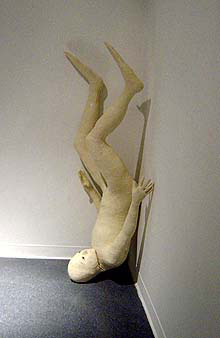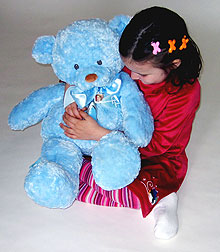April 4, 2005
Sesnon Gallery features innovative exhibit
by three new art faculty
By Scott Rappaport
Innovative, kinetic, and sonic installations merging sculpture,
electronic media, and performance art will be on display in
Faculty Works: 2005 at UCSC’s Sesnon Gallery. The
exhibit, from April 6 to May 7, will feature works by three
new art faculty members: Dee Hibbert-Jones, Ed Osborn, and Jennifer
Parker.

Skinned (Sound Residue) by Jennifer Parker is a sound
sculpture/installation life-size latex figure and skin with
five crocheted speaker pods and receiver.
Photo: Jennifer
Parker |

Separation Anxiety Disorder Teddy
Backpack by Dee Hibbert-Jones is from her “Psychological
Prosthetics” installation/performance.
Photo: Dee
Hibbert-Jones |
Dee Hibbert-Jones was recently hired as an assistant
professor to develop the public art program at UCSC.
Her current research explores the relationships between art,
commerce, and mental health in a project she calls “Psychological
Prosthetics.” In collaboration with mental health workers,
she has created (and patented) a brand of sculptural products
designed to aid mental health disorders. The products employ
sleek, high-tech designs with gadgetry attached such as LCD
monitors, push-buttons for audio, and telescoping sections for
portability.
Hibbert-Jones’s creations include a Separation Anxiety
Disorder Teddy Backpack and an Attention Deficit Disorder
Brace. She has also constructed a Post Traumatic Stress
Disorder Security Vest—complete with an LCD screen
to cathartically retell a personal trauma story, a stress gauge
connected to body temperature, and a walkie-talkie check-in
device to monitor personal safety.
“Sculpture is an emotion made tangible,” Hibbert-Jones
explained. “I’m exploring the role of the artist as
healer by creating a tangible product to soothe a mental health
disorder. If someone is having an anxiety attack, I can give
them something to hold or wear like a security blanket. I look
at ideas like: ‘How do you create an environment that creates
an emotional response of safety?’ or ‘What kinds of
things help?’”
Hibbert-Jones said she conceived her project while reflecting
on the massive influence of the psycho-pharmaceutical industry.
The presentation of her products mimics a corporate display,
using the language of the pharmaceutical industry in text, logo,
colors, and signage. “I’m turning the Sesnon Gallery
into a trade show of psychological prosthetics,” said Hibbert-Jones.
“I’ll have an infomercial about the products on display,
banners advertising the products, and photos on the walls of
people wearing and using the products.”
Like political theater, Hibbert-Jones’s work is both serious
and satirical, with the intent of stimulating discussion of
important issues related to mental illness, diagnosis, prescription,
and treatment. The Sesnon installation will also include an
interactive performance art aspect—outside the gallery,
performers in lab coats will interview people about depression
and anxiety to kick-start conversations about mental health.
Hibbert-Jones said that she will take the project on tour later
this year to museums and galleries throughout the United States.
She also noted that a portable “Psychological Prosthetics
Trauma Unit” will tour Europe in 2006.
Assistant Professor Jennifer Parker’s sculptures
and installations combine found and manipulated sounds, organic
material, video, and performances. Her contribution to the Faculty
Works: 2005 exhibit will include Wigsuit, a performance
sculpture consisting of a suit she constructed from over 100
wigs manufactured in Japan; and Self-Portrait, a piece
created in response to the 2004 presidential elections made
up of oil clay and digital images.
Parker will also exhibit a life-sized latex figure and skin
with five crocheted speaker pods titled Skinned (Sound Residue).
She said the work was created “as a result of thinking
about sound as vibration…waves bounding off the body or
being absorbed by the body. I imagined silence—a figure
with no ears, having recently hatched or shed her skin…and
of sounds embedded in the skin…left behind as residue of
her life.”
Ed Osborn, assistant professor of electronic and digital
media, was born in Helsinki, Finland, and is now based in Oakland
and Berlin. His sound art pieces come in a variety of forms,
including installations, sculpture, radio, video, and public
performance projects. Osborn’s works range from rumbling
fans and sounding train sets to squirming music boxes and delicate
feedback networks.
For the Sesnon exhibit, Osborn will create a remix of Attempting
Ziggurats, based on the story of the Tower of Babel and
its ongoing reverberations in American culture. “The forms
of social, political, and economic organizations needed to build
the Tower of Babel--those of a massive system of coercion in
service of an enormous and delusional task—are ones that
recur frequently in American history,” Osborn noted.
An opening reception will be held on Wednesday, April 6,
from 5 to 7 p.m. Sesnon Gallery hours are Tuesday through Saturday
from noon to 5 p.m. A lecture series with a talk by each of
the artists will take place at Porter College Faculty Gallery:
Dee Hibbert-Jones, April 12; Ed Osborn, April 13; and Jennifer
Parker, April 20. For more information, go to: http://arts.ucsc.edu.
 Email this story
Email this story
 Printer-friendly version
Printer-friendly version
 Return to Front Page
Return to Front Page